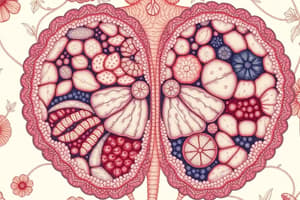Podcast
Questions and Answers
What is the primary function of the stomach within the digestive system?
What is the primary function of the stomach within the digestive system?
- Transport of nutrients
- Storage and digestion of food (correct)
- Production of bile
- Absorption of water
Which organ system includes the heart and blood vessels?
Which organ system includes the heart and blood vessels?
- Digestive system
- Endocrine system
- Respiratory system
- Cardiovascular system (correct)
Which tissue type is predominantly found in the root of a plant?
Which tissue type is predominantly found in the root of a plant?
- Connective tissue
- Nervous tissue
- Muscle tissue
- Epidermal and vascular tissues (correct)
What role do smooth muscle layers play in the intestine?
What role do smooth muscle layers play in the intestine?
What is a primary function of the liver?
What is a primary function of the liver?
Which type of tissue is primarily found lining the inside of the intestine?
Which type of tissue is primarily found lining the inside of the intestine?
Which organ system is responsible for eliminating carbon dioxide from the body?
Which organ system is responsible for eliminating carbon dioxide from the body?
What is the main function of the leaf in plants?
What is the main function of the leaf in plants?
What is the main role of the digestive system organs as mentioned in the content?
What is the main role of the digestive system organs as mentioned in the content?
How do the respiratory and circulatory systems collaborate?
How do the respiratory and circulatory systems collaborate?
What role do the endocrine glands play in the human body?
What role do the endocrine glands play in the human body?
What would happen if the stomach stopped churning?
What would happen if the stomach stopped churning?
What defines the functions of the nervous system?
What defines the functions of the nervous system?
Which type of glands release hormones directly into the bloodstream?
Which type of glands release hormones directly into the bloodstream?
What is a key factor contributing to the effectiveness of organ systems working together?
What is a key factor contributing to the effectiveness of organ systems working together?
What is one function of glands mentioned in the document?
What is one function of glands mentioned in the document?
What is the primary characteristic of epithelial tissue?
What is the primary characteristic of epithelial tissue?
Which type of tissue is primarily responsible for supporting and connecting other tissues and organs?
Which type of tissue is primarily responsible for supporting and connecting other tissues and organs?
Which of the following types of muscle tissue is under voluntary control?
Which of the following types of muscle tissue is under voluntary control?
What is the main function of nervous tissue?
What is the main function of nervous tissue?
Which statement best describes connective tissue?
Which statement best describes connective tissue?
Which layer of organization is formed by a collection of tissues working together to perform a specific function?
Which layer of organization is formed by a collection of tissues working together to perform a specific function?
What type of cells are considered the basic functional unit of the nervous system?
What type of cells are considered the basic functional unit of the nervous system?
Which type of muscle tissue functions involuntarily to pump blood?
Which type of muscle tissue functions involuntarily to pump blood?
Flashcards
Epithelial Tissue
Epithelial Tissue
Tightly packed cells forming continuous sheets, acting as barriers and covering surfaces of organs, lining cavities and canals, forming ducts and glands, including skin and gut lining.
Connective Tissue
Connective Tissue
Diverse cell types (like fibroblasts and fat cells) supporting and connecting tissues and organs.
Muscle Tissue
Muscle Tissue
Contractile tissue containing myosin and actin filaments, enabling movement and functions like blood pumping and digestion.
Nervous Tissue
Nervous Tissue
Signup and view all the flashcards
Tissue
Tissue
Signup and view all the flashcards
Organ
Organ
Signup and view all the flashcards
Cell Types
Cell Types
Signup and view all the flashcards
Tissue Polarization
Tissue Polarization
Signup and view all the flashcards
Organ Systems
Organ Systems
Signup and view all the flashcards
Interdependent Organ Systems
Interdependent Organ Systems
Signup and view all the flashcards
Digestive System Function
Digestive System Function
Signup and view all the flashcards
Respiratory and Circulatory System Cooperation
Respiratory and Circulatory System Cooperation
Signup and view all the flashcards
Circulatory System Functions
Circulatory System Functions
Signup and view all the flashcards
Control and Coordination Systems
Control and Coordination Systems
Signup and view all the flashcards
Nervous System Control
Nervous System Control
Signup and view all the flashcards
Endocrine System Control
Endocrine System Control
Signup and view all the flashcards
What is the main function of the stomach?
What is the main function of the stomach?
Signup and view all the flashcards
What are the main tissues found in the heart?
What are the main tissues found in the heart?
Signup and view all the flashcards
What is the function of the liver?
What is the function of the liver?
Signup and view all the flashcards
What is the main function of the root?
What is the main function of the root?
Signup and view all the flashcards
What is the main function of the stem?
What is the main function of the stem?
Signup and view all the flashcards
What is the main function of the leaf?
What is the main function of the leaf?
Signup and view all the flashcards
What is an organ system?
What is an organ system?
Signup and view all the flashcards
What is the function of the cardiovascular system?
What is the function of the cardiovascular system?
Signup and view all the flashcards
Study Notes
Introduction to Biology - BIO 101
- The human body is composed of several organs and glands, including the adrenal gland, thyroid, pancreas, pituitary gland, brain, ovary, testicle, and thymus.
Level of Organization
- The body has levels of organization: atom, molecule, macromolecule, organelle, cell, tissue, organ, organ system, and organism.
Tissue
- Tissues are groups of cells with similar structure and function.
- Tissues perform specific activities.
- Tissues are held together by extracellular fluid and fibers.
- There are four major tissue types: epithelial, connective, muscle, and nervous.
- More than 200 different cell types exist in the body, which constitute these tissues.
Epithelial Tissue
- Composed of tightly packed cells in layers.
- Acts as barriers to fluids and microbes.
- Lines cavities, forms tubes and ducts.
- Forms the epidermis of the skin and lines internal surfaces such as the gastrointestinal tract (GIT).
- Cells in this tissue are polarized (apical and basal side).
Connective Tissue
- Made up of diverse cell types, including fibroblasts, fat cells, and blood cells.
- Supports and connects other tissues and organs.
- Different types of connective tissues, including loose connective tissue, fibrous connective tissue and cartilage, are shown in illustrative visuals.
- Blood is also a connective tissue, pictured and described in detail.
Muscle Tissue
- Essential for movement, posture, and blood circulation.
- Composed of cells called muscle fibers able to contract.
- Three types of muscle tissue include skeletal (voluntary), smooth (involuntary), and cardiac (heart).
Nervous Tissue
- Highly specialized tissues for sensing and transmitting information.
- Consists of neurons and glial cells.
- Neurons are the functional units of the nervous system.
- Glial cells support neuronal function.
Organ
- A collection of tissues working together to perform a specific function.
- Examples include the stomach, liver, lungs, heart, pancreas, spleen, kidneys, and eyes.
Organ Systems
- Groups of organs with coordinated functions.
- Cardiovascular system: circulates blood, carrying oxygen and nutrients to cells, and removing waste.
- Respiratory system: brings in oxygen and removes carbon dioxide. Other systems and the organs they comprise are also described.
Major Organ Systems
- Organ systems work together to ensure proper functioning of the whole organism.
- Different systems (cardiovascular, lymphatic, digestive, endocrine, integumentary, muscular, nervous, reproductive, respiratory, skeletal, urinary, and immune) have specialized functions.
- These are elaborated upon with descriptions of their functions, involved organs, tissues and structures.
Organs in Systems
- Organs in a system work in coordination to perform a specific task or process.
- A particular illustration of how the digestive system functions is shown to explain the importance of coordinated actions.
Organ Systems Working Together
- Organ systems cooperate to maintain the body's overall function.
- The respiratory and circulatory systems work in tandem to deliver oxygen and remove carbon dioxide, which is visually illustrated.
Control and Coordination
- The nervous and endocrine systems control and coordinate body functions.
- The nervous system uses electrical impulses to regulate quick responses to stimulations.
- The endocrine system uses hormones regulated by feedback mechanisms—to control body functions and processes slowly.
Gland
- Glands are organs that produce and release substances with specific functions.
- Two types of glands: endocrine and exocrine.
- Endocrine glands release hormones into the bloodstream to regulate a variety of bodily functions.
- Exocrine glands release substances through ducts to the external parts of the body.
- Different illustrations explain the differences in the functioning of endocrine and exocrine glands, and their functions.
Endocrine Glands
- Part of the endocrine system; produce and release hormones into the bloodstream to regulate bodily functions.
- Examples include the pituitary, thyroid, adrenal, pancreas, ovaries, and testes.
Exocrine Glands
- Release substances through ducts to the exterior of the body.
- Examples include the salivary, sweat, mammary, sebaceous, and lacrimal glands.
Common Glands and Hormones
- Various glands produce certain hormones with specific roles. Specific glands and their roles, and the hormones produced by them are detailed in tables.
Who Regulates the Regulators?
- The endocrine system is regulated through a network of negative feedback loops.
- This helps to maintain homeostasis.
- An example of blood glucose regulation is detailed.
Studying That Suits You
Use AI to generate personalized quizzes and flashcards to suit your learning preferences.



